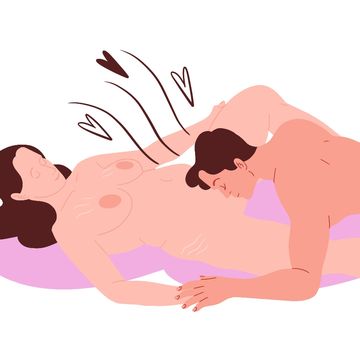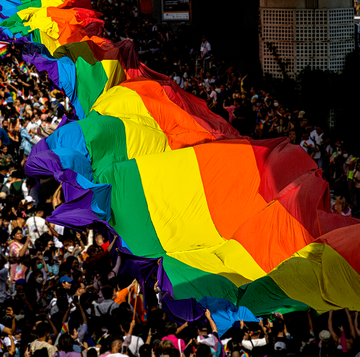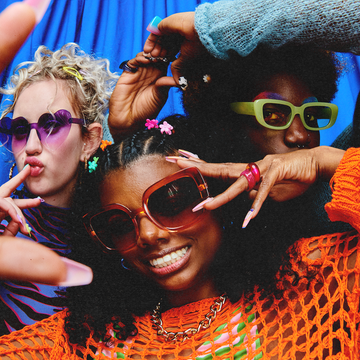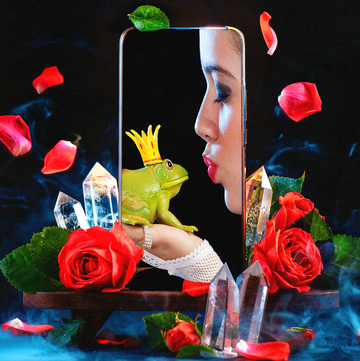Because people are always evolving—both individually and as a society—language continues to evolve as well. And one of the most exciting ways language has progressed is through the use and understanding of gender-neutral pronouns.
According to the LGBTQ+ resource center at University of Wisconsin-Milwaukee, gender-neutral pronouns are “inclusive pronouns that do not associate any gender with the individual being discussed.” These are different than he/his and she/hers pronouns, which are specifically gendered pronouns.
Now before we dive deeper into it and what gender-neutral pronouns look like, it’s important to know that learning, using, and respecting someone’s pronouns are a necessary part of daily interaction.
So whether you personally have gender-neutral pronouns, are trying to figure out which pronoun(s) are best for you, or are looking to be a better ally, you’ve come to the right place. With the help of some experts, we’re breaking down everything you need to know about gender-neutral pronouns.
What are the gender-neutral pronouns?
New uses of language are constantly evolving to encompass the diverse experiences of gender. Here are some of the most common gender-neutral pronouns you should know:
1. They/Them/Their
The most frequently used gender-neutral pronouns are they/them/their. “They/them are widely used among those who do not identify with she/her or he/him pronouns and are becoming increasingly accepted into mainstream culture,” says Iris Gottlieb, author and illustrator of the book Seeing Gender: An Illustrated Guide to Identity and Expression.
The main misconception surrounding the pronouns they/them is that they’re grammatically incorrect because they’re plural pronouns. However, we use they/them/their in singular ways often, such as “someone left their phone.” One of the reasons they/them/their is the most widely used is because the words are familiar, making them more quickly adopted than some of the less familiar pronouns.
2. Ze/Zir/Zirs
(pronounced zee/here/heres)
If you’re wondering why there are additional pronoun options when “they” is already available, therapist Stefanie Juliano, a licensed clinical professional counselor, explains that something like “ze/zir/zirs” offers a sense of identity instead of the absence of identity.
“Ze felt like it was associated with the presence of another gender besides male/female rather than just the neutrality of gender. It is sort of like having the options on a gender list saying male, female, non-binary, or genderqueer instead of listing only male, female, or ‘other.’”
3. Ey/Em/Eirs
(pronounced ay/em/airs)
Ey/em/eirs are shortened versions of they/them/their that began use in 1975 when Christine Elverson entered and won a contest by the Chicago Association of Business Communicators to find neutral pronouns.
4. Mx.
(pronounced miks)
Mx. is the non-binary version of Ms./Mrs./Miss/Mr., terms referred to as honorifics. So for example, you could address a formal invitation or letter to Mx. [last name].
5. Proper Name Only
Debi Jackson, a diversity trainer with the organization Gender Inclusivity and also mother of a transgender daughter, shares that not everyone has pronouns that work for them.
“Language is vast and can encompass a lot of ideas, but it still has its limitations. I know several non-binary trans folks who do not feel comfortable with any pronoun options out there. In that case, it takes some effort to structure sentences without the use of a pronoun, but it can be done. For example, ‘Uri has an upcoming appointment with Dr. Brown. Please remind Uri to arrive 15 minutes early and to fill out Uri’s insurance information before arriving. Uri can check in online or at the front desk once Uri arrives.’ The person’s name is used a lot, but that is better than attaching language on that person that does not feel comfortable or safe.”
The history of gender-neutral pronouns
The 2019 Merriam-Webster word of the year was “they,” showing how widely relevant and important it’s become to understand gender-neutral pronouns. But 2019 wasn’t the start of gender-neutral pronouns. In fact, linguist and founder of Meridian Linguistics Sara Maria Hasbun says genderless pronouns are actually as old as time. “Many languages, including Korean and Turkish, use genderless pronouns exclusively,” she explains. “Chinese only specifies the gender when writing but not when speaking.”
As for English, it’s not quite as clear when genderless pronouns first appeared, but Hasbun says they’ve been around pretty much since English started sounding like the language we use today (which was around the 1500s, FYI). “It is very possible genderless pronouns were used earlier than that and just didn’t make it into writing,” she explains.
How to use gender-neutral pronouns
If you’re new to using gender-neutral pronouns, you might be wondering how to form a sentence with words like “they” replacing words like “he” or “she.” Hasbun says in traditional American English dialect—like what I’m typing and what you’re reading—it’s standard to follow the prescribed verb agreement. Let me pull out my digital chalkboard and give you an example:
You’d say, “They like to go to the store” (as opposed to “they likes” to go to the store), even when talking about a singular person.
If that sounds strange, Hasburn says to keep in mind verb-agreement rules are pretty much bullshit in any language. “In Spanish, you use third-person verb endings when speaking to a formal ‘you,’” she says. “Why? Because language. There’s no use fighting it.”
And Hasburn strongly encourages everyone to adapt their language usage. “It’s worth putting your best efforts into accommodating pronoun requests as part of being a respectful human being,” she explains.
How to know what pronouns are best for you
It can feel a little confusing if you’re not sure what pronoun(s) to use or which ones are best for you. The trick is to just try them out to see what works. “It’s kind of like trying on a new shade of lipstick,” explains Lived Experience educator and advocate Sonny Jane. “You might need to wear it for a while to see if it’s your shade or not (and sometimes our ‘shade’ might change too, and that’s okay!).” They recommend asking your friends or inner circle to call you the pronouns you’re interested in to test out how they feel.
Also, it’s okay if your pronouns evolve and change over time. This isn’t a one-size-fits-all-forever kinda thing, so give yourself grace and be open to evolving your language usage and identity.
How to share your pronouns with others
If you feel ready to share your pronouns, there are a few ways you can do it. “Share with your most educated and supportive friends and community first,” advises licensed marriage and family therapist Adrienne Michelle. This way, you won’t be faced with the dual task of sharing your identity and having to educate.
When/if you want to expand the convo, Jane notes it can be helpful to simply explain what pronouns are and why they’re an important part of your identity. “That makes it easier when you explain how changing your pronouns is important for your well-being,” they explain.
Just to be clear though, it is not your job to educate anyone on the importance of pronouns or defend why you are using them. So whether you tell family, social media followers, or friends, Jane says you’re “allowed to share your pronouns in a way that’s comfortable and safe for you.” Do what feels best.
How to ask for someone’s pronouns
The best way to learn someone’s pronouns is by simply stating yours. “Introduce yourself first with your pronouns,” advises relationship therapist Darcy Sterling, PhD, host of E!’s Famously Single. “Stay away from using specific pronouns like she/her and he/him if you do not know someone’s pronouns yet.”
Gottlieb says understanding proper use of gender-neutral pronouns extends beyond just asking people and points out that someone “might prefer ‘he/him’ in a business context and ‘they/them’ around friends.”
“Ultimately, we have to trust that people will use the pronouns that feel best for them and not question it,” Gottlieb says. “And if later down the road, those pronouns change, then the new pronouns should be adopted. We all want people to respect our gender identities and expressions and asking for pronouns is a simple way to gain information to better understand one another and ensure we address each other in a way that feels good.”
What to do if you’re misgendered
First off, so sorry that happened. Second off, you may want to practice how you will react so you can be better prepared if it happens again. “Practicing may sound silly, but it can help you feel comfortable for the situation when it arises,” says Sterling.
Also, you should correct someone only if you feel comfortable, but as Jane wisely notes, “your gender is valid and who you are deserves to be respected.” They suggest simply pointing out that you use *insert your pronouns here* and moving on, like you would correct someone for pronouncing your name incorrectly.
Michelle adds that if someone continues to confuse your pronouns—whether accidentally or intentionally—ask a pal to back you up in correcting them. This is the perfect time to get your support system involved, and the next thing you know, everyone will be shouting your correct pronouns the next time someone gets them wrong.
What to do if you accidentally misgender someone
Accidentally misgendering someone is (1) a shitty feeling but (2) might happen, and there’s a right and wrong way to correct your mistake. Michelle suggests doing some internal work to figure out why it’s hard for you to remember. “This is not the person’s fault, so save the speech about apologizing and how you didn’t mean to, and actually put some work into making sure it doesn’t happen again,” she advises.
“This can also help us explore gender for ourselves. Maybe we are used to our ideas of what is feminine or masculine or the binary clouds our thoughts on who someone is or should be.”
Psychiatrist Era Dutta, MD, notes that if you realize after the fact that you used the incorrect pronouns, make it a point to be particular the next time. Simply adjusting your language will show you caught your mistake and are respecting their identity.
How to be a better ally for those who have gender-neutral pronouns
Even if you present as the same gender as your pronouns, offering your pronouns as routine can make others feel comfortable to do the same. Juliano suggests including your pronouns in emails, name tags, social media, and other identification. Getting into the habit of introducing yourself with your pronouns, even if they are typical of your gender presentation, can open the conversation and give others an opening to share too.
Rachel Varina is a full-time freelance writer covering everything from the best vibrators (the Lelo Sona) to the best TV shows (The Vampire Diaries). She has over 10 years of editorial experience with bylines at Women's Health, Elite Daily, Betches, and more. She lives in Tampa, Florida, but did not feed her husband to tigers. When she's not testing out new sex toys (100+ and counting so far!), she's likely chilling with her dogs or eating buffalo chicken dip. Ideally at the same time. Follow her on Instagram and Twitter.













